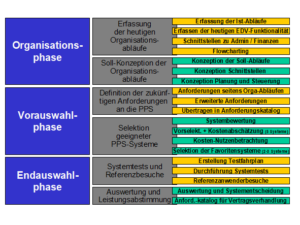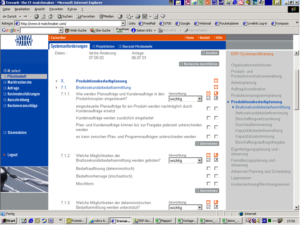Trovarit concludes cooperation agreement with Abels & Kemmner for the systematic selection and introduction of ERP, PPS and merchandise management systems
The decision for an ERP, PPS and/or merchandise management system is increasingly one for the entire life of the company, or at least for many years to come. At the same time, it is a difficult and delicate task and not for the inexperienced.
On the one hand, the software market is almost unmanageable due to the numerous offers, which are also difficult to compare, as well as its high dynamics, on the other hand, the applications often represent an elementary component of the operational infrastructure and organizational processes, so that a wrong decision can have far-reaching consequences, not only due to the high investment volumes. A qualified selection of ERP, PPS or merchandise management systems therefore requires a systematic approach and a great deal of experience.

With the certification as “IT-M-consultant” by Trovarit AG, Abels & Kemmner was accepted into the small but select group of consultants who are well versed in the selection of ERP, PPS and merchandise management systems. Trovarit recommends these consultants to potential users of the IT-Matchmaker database. IT-Matchmaker is the leading database in Germany for the selection of ERP, PPS and merchandise management systems in terms of the topicality and detail of the criteria.
The ERP selection specialists at Abels & Kemmner have been involved in the comparison, selection and optimization of ERP, PPS and merchandise management systems for over 15 years and have been using IT Matchmaker for this purpose since it became available. The IT-M certification recognizes Abels & Kemmner’s many years of experience in the systematic and vendor-independent selection of ERP systems.
How to systematically select and introduce ERP, PPS and merchandise management systems will be examined in more detail below:
The first step is to define the target requirements
Anyone looking for a new ERP system must first know what they want.
Most of the requirements for a new system must be derived from the organizational processes that are to be supported in the future with the help of the system to be selected. In order to be able to formulate the right requirements for an ERP system, the organizational processes (“business processes”) must therefore be recorded and sometimes also “straightened out”, because incorrect organizational processes lead to incorrect requirements and therefore incorrect ERP systems, which in turn cement the wrong organization. A comparison of two automotive suppliers in North Rhine-Westphalia shows how important it is to analyze organizational processes. Both competitors manufactured the same products for the same customers with roughly the same size of around 600 employees. While in one company the organizational processes were specifically supported by the ERP system used, in the second company an attempt was made to replicate the established organizational processes with the ERP system. This resulted in additional annual costs of 500,000 euros, as benchmarking showed. In this respect, the optimization of business processes is not a consultant’s trick to rake in fees, but a necessary evil that should be endured at least when introducing ERP systems. And there is another argument in favor of this: companies looking for a new ERP system today have been using their previous system for an average of 7 to 10 years. No one will deny that environmental conditions have changed fundamentally during this time. However, no one will be able to credibly prove that they have reacted 100% to these changes, because humans are creatures of habit and existing processes become ingrained. The desire to change or introduce an ERP system is also always an indication that a change is necessary and desired. The digitalization of processes in the ERP system only ensures productivity gains, the preceding optimization of organizational processes creates them. However, once the future business processes have been defined, two questions still need to be answered:
1. on the one hand, the operational and strategic boundary conditions of the company must be taken into account. These can be requirements regarding the size of an ERP provider or the hardware platform to be used, for example. Over the years, Abels & Kemmner has compiled and refined an extensive catalog of questions for this purpose.
2. on the other hand, organizational and technical integration or interface requirements on the part of the technical, commercial and administrative software systems (e.g. CAD, financial accounting) must also be taken into account.
Once these tasks have been completed, the knowledge gained must be translated into the it-matchmaker’s catalog of criteria before the large number of ERP systems available on the market can be checked for their suitability for the needs of your own company.
The database query
Due to the large number of systems available on the market, Abels & Kemmner uses the IT Matchmaker database from Trovarit AG, Aachen, in a pre-selection phase. This constantly updated database provides the most up-to-date overview of the relevant ERP and PPS systems available on the market. Due to the large number of stored criteria, it is differentiated in the selection but complex in the interpretation of the requirement criteria.

When selecting ERP systems, however, it is often not only suitable order processing-oriented modules from the area of production planning and control that are sought. The ERP systems should also meet the requirements of finance and accounting. For this reason, Abels & Kemmner has added further criteria to the functional criteria of the IT Matchmaker in the area of finance and accounting. In practice, it often turns out that the needs of PPS and finance and accounting are at odds with each other. Systems that meet the requirements of one side do not meet the requirements of the other. If this effect occurs during the functionality-oriented preselection of suitable software systems, it is advisable to first define which side should be given priority in case of doubt. In the final selection, which should only deal with 2 to 3 systems and examine them in detail, solutions can then be developed together with the system providers to close the gap.
Analysis of the favorites
Once two to three ERP systems have been determined at the end of the pre-selection phase which, according to IT Matchmaker, meet the functional requirements, the subsequent final selection phase involves analyzing the pre-selected systems even more closely in workshops with the system providers by means of system presentations and detailed test schedules based on the company’s own operational data. The quality and informative value of this project step depend heavily on the quality of the test schedule. Some effort should therefore be invested in it.
The system tests should be followed by visits to reference users. These visits supplement the process analysis with important information on the performance, reliability and manageability of the system in practice.
If the degree of fulfillment of a favorite system clearly stands out from the other systems in the preselection and this system is also far ahead in the price-performance ratio, you can concentrate on this system first in the further considerations of the final selection. Depending on the results of the system test and the user visit(s), a decision is then made as to whether further systems should be included in the final selection.
However, the final selection phase is not yet over with the system decision. Finally, the functional criteria from the pre-selection phase and the results and agreements from the final selection phase are used to compile a catalog of requirements that becomes a simplified specification sheet that forms the basis of the contract between the system provider and the company.
However, functional suitability is only a necessary, but not a sufficient requirement for an ERP system. The aim must be to provide the company with a software system that delivers the required services as cost-effectively as possible. This objective makes it necessary, on the one hand, to identify the systems with the best price-performance ratio against the background of the functional requirements and, on the other hand, to convince the selected system supplier to incorporate as many functional adaptations as possible into the future standard. In this way, the service provided by the consultant when selecting software not only represents a kind of “insurance premium” for a functionally correct system decision, but also pays for itself through the savings made on future investment and operating costs.
The sum of the advantages of systematic ERP selection
The systematic selection of an ERP system not only guarantees that a suitable system has been selected. The process also ensures that the rationalization effects that the company expects from the introduction of the system are not eaten up by the one-off and ongoing costs of the system. Furthermore, discussions about promised functionalities and adaptation costs to be paid for during the subsequent system implementation are largely avoided. The system can also be introduced more quickly and cost-effectively in this way, as the necessary adjustments are identified at an early stage and the resulting costs can be negotiated at a time when the customer, and not the system provider, has the upper hand. This is why a systematic system selection supported by experienced experts always pays off.

